TreaTmenT | Interview | “The idea was psychedelia—the real thing.”
In the anarchic whirl of the 1980s psychedelic underground, TreaTmenT emerged as unsung sorcerers, captivating audiences at the Stonehenge Free Festival and at legendary venues like Alice In Wonderland and The Crypt.
Their sonic blitz, a potent mix of 1960s psychedelia, 1970s space rock, and punk defiance, distinguished them as one of the most mind-altering bands of their era. Sharing the stage with Dr. & The Medics, Ozric Tentacles, and The Magic Mushroom Band, TreaTmenT were central to the neo-psychedelic revival. Known for their explosive live performances that fused Arthur Brown’s Kingdom Come with early Pink Floyd’s mystique, all under a dazzling light show, they created an unforgettable live experience.
Despite their electric presence and releases like ‘Cypher Caput,’ the full extent of their impact was never fully captured on vinyl—until now. After nearly three decades, ‘How Much Is Enough?’ finally emerges from the vault, serving as a late but powerful tribute following the tragic passing of guitarist Gordon Leach in 2021. Originally slated for a 2000 release on Delerium, this album stands as a monumental act of reconciliation with their tumultuous past.
The album’s packaging—a treasure trove of photos, memorabilia, and a complete band history—serves as a potent symbol of closure, encapsulating years of musical mayhem and unfinished business. Even with a wealth of unreleased material still lurking in the shadows, TreaTmenT’s music, though grounded in the familiar language of rock, remains a startlingly unique artifact of its time. Limited to only 300 copies on 180-gram vinyl, this release is set to become a definitive piece for fans of the genre.
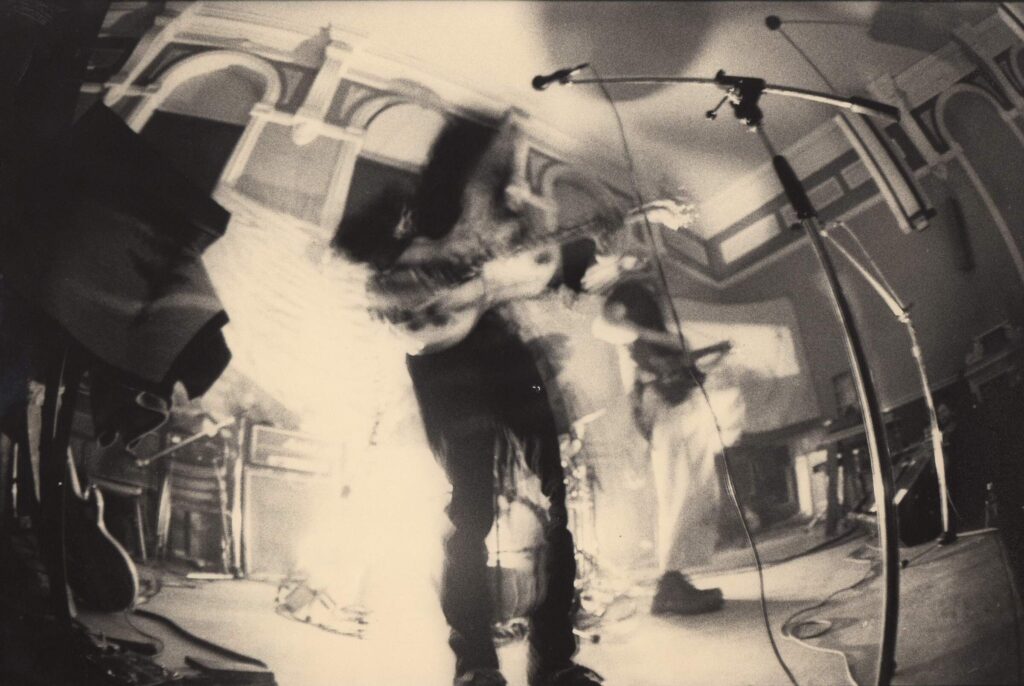
“The idea was psychedelia—the real thing.”
Would you like to share about your upbringing? Where did you all grow up? Tell us about daily life back in your teenage years.
Adam Blake: I grew up in London—West Hampstead, Regent’s Park. Daily life in my teenage years revolved pretty much entirely around playing records and trying to learn to play the guitar.
Was there a certain scene you were part of? Maybe you had some favorite hangout places? Did you attend a lot of gigs back then?
I went to as many gigs as I could from the age of 12. Initially, I wanted to be a hippie, but I was a bit late. There are certain gigs that I can remember that changed my life. Traffic and John Martyn at the Rainbow, April 12th, 1973. That was the one where I decided that I wanted to be a musician. I remember something called the NME/Virgin Crisis Tour in the winter of 1974. For 49p, I saw Lol Coxhill, Steve Miller, Hatfield & The North, Fred Frith, and Kevin Coyne. That was quite an educational evening. Sunday afternoon gigs at the Roundhouse in Chalk Farm were where I saw loads of bands. When I got to be 16 (summer of 1976), I would go to gigs all the time if I could get in and if I had the money—pub rock, punk rock, alternative, whatever…
If we were to step into your teenage room, what kind of records, fanzines, posters, etc., would we find there?
The NME was my bible from about 1974 on. I would read it avidly. I had posters all over my walls—Alice Cooper, Jimi Hendrix, Frank Zappa… I was such a teenage rock fan. I was quite an obsessive record collector (still am). I would go to Church Street Market off the Edgware Road every Saturday and scavenge the junk shops. In those days, there were piles of 78s and knackered singles and LPs all over the place.
Was TreaTmenT your very first band, or were you involved with any other bands?
No, my first band was Captain Comedown with Clive Leach and Gordon Leach, who were also in TreaTmenT. Then I was in The Cannibals—Mike Spenser’s band—which Clive also joined later.
Can you elaborate on the formation of the TreaTmenT?
Not really. The Treatment formed as a four-piece—without me! I went down to an early rehearsal, and they were playing ‘Stamp Out Mutants,’ and I thought I HAD to get involved in it! So I basically wheedled and hassled my way in—just as I had done to Captain Comedown three years earlier! Hah!
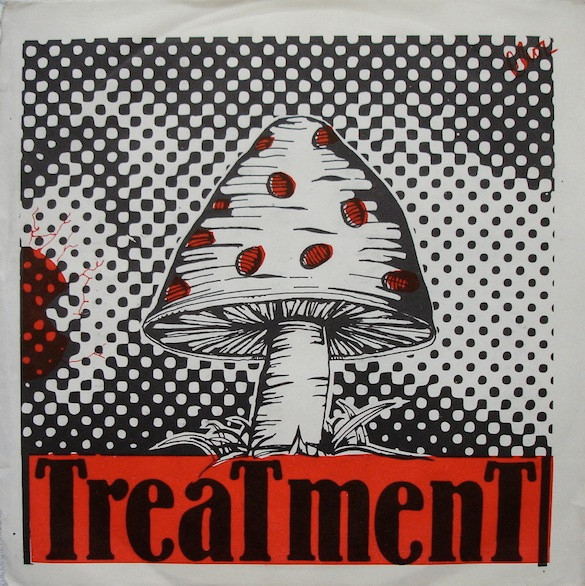
Could you walk us through the genesis of the band and how your diverse influences coalesced into your unique sound?
Hmmm… It took me years before I realized that the TreaTmenT was basically Clive’s idea of a tribute band to Arthur Brown’s Kingdom Come. But that was OK. I loved Arthur Brown’s Kingdom Come. Really, the idea was psychedelia—the real thing. We were all very enamored of Syd Barrett’s Pink Floyd and Soft Machine, etc. But we had come up through punk, so… You have to remember that the end of the 1970s and the beginning of the 1980s were a funny time. There was a lot of talk about “post-rock” and industrial music and suchlike. We were trying to do something new with the basic ingredients of rock: guitars, bass, keyboards, drums. Or at least something original.
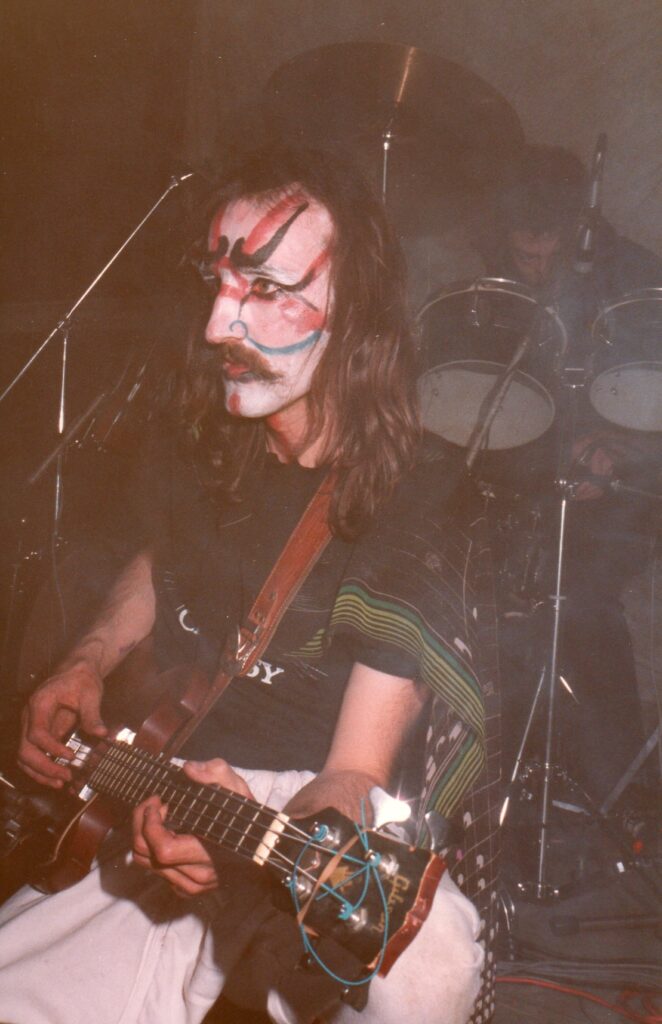
What influenced TreaTmenT’s sound?
We were very influenced by Psycho Hamster, who were a band that Gordon and Paul Ross played with up in Colchester. They really had the Anarchist psychedelic/punk thing happening. Unfortunately, they were too unstable to last very long, but they were a big influence.
What’s the story behind your band name?
There wasn’t one, really. Not that I can remember.
What kind of places did you play early on? What are some of the bands you shared stages with?
The first proper TreaTmenT gig was at a youth club called The Basement in Covent Garden. We played there a couple of times. We also played at a drama college in North London called Ivy House. We used to play the Rock Garden in Covent Garden fairly regularly, the London Musicians Collective in Chalk Farm, and free festivals like Stonehenge and Norwich. Bands we shared stages with included Psycho Hamster, Miles Over Matter, The Lemon Kittens, and Sad Among Strangers.
The band’s association with the Clinic club and figures like Clive Jackson, also known as The Doctor, played a role in your integration into the London psychedelic underground. How did these connections shape the band’s visibility and opportunities within the music scene?
Well, that whole scene was a bit of a damp squib, really. It didn’t really get going until 1984 with the Alice In Wonderland Club at Gossips. Clive (The Doctor) was very nice, though; he used to play our single at The Clinic, and we gigged there a couple of times.
You were part of the so-called UK Free Festivals movement. There’s a fantastic book called Festivalized: Music, Politics, and Alternative Culture by Ian Abrahams & Bridget Wishart. Would you like to elaborate on how you view the scene from today’s perspective?
Like a lost world in many ways. After the Battle of the Beanfield in 1985, there was no more free festival scene to speak of, at least from my point of view. I remember Treworgey in 1989, where someone put a dead rat in the water tank. That seemed to sum up what had happened to that scene. Plus, the Brew Crew ruined everything they came near. But it wasn’t a “so-called” UK Free Festivals movement. It was the UK Free Festivals movement. I’m very glad I was at Stonehenge in 1980, 81, 82… It was as close to anarchy in action as I’m ever likely to get.
Would love to hear about the early tapes, ‘Live At Stonehenge’ and ‘Intensive’…
‘Live At Stonehenge’ was recorded at Stonehenge in 1981 and 1982. The 1982 recording has Nik Turner from Hawkwind sitting in with us—which was lovely. Magic, really. Intensive was a 46-minute compilation that I put together out of the tapes that Jonny Chubb made of gigs and rehearsals. We sold it at gigs and via mail order from the squat we were living in at the time. I was proud of it.
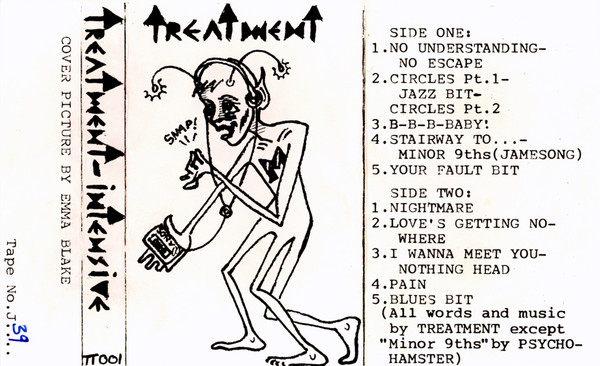
What was it like to play Stonehenge?
Quite something. In 1980, we were quite literally blown offstage—by the wind. I had an amplifier on wheels, and I remember watching it slowly wheel off to the side of the stage. We played very badly! 1981 was much better. Sadly, it didn’t get recorded, but we lucked into the best slot on Saturday night, and we played very well. We always played well to big audiences. We played on Sunday afternoon as well, and part of that did get recorded and made its way onto the tapes. 1982 was a bit traumatic because our campsite had been invaded by a hostile chapter of the Hells Angels. The stage was actually a safe place. Again, we lucked into the best slot on Saturday night, and again, we played very well. Having Nik Turner appear onstage was such a bonus. 1983 was a bit chaotic. We’d sort of officially split up at that point, but we wanted to play Henge. I remember we had a lot of equipment problems, but we soldiered on. And that was when Big Steve said, “Let’s have a round of applause for a band that doesn’t exist anymore.”
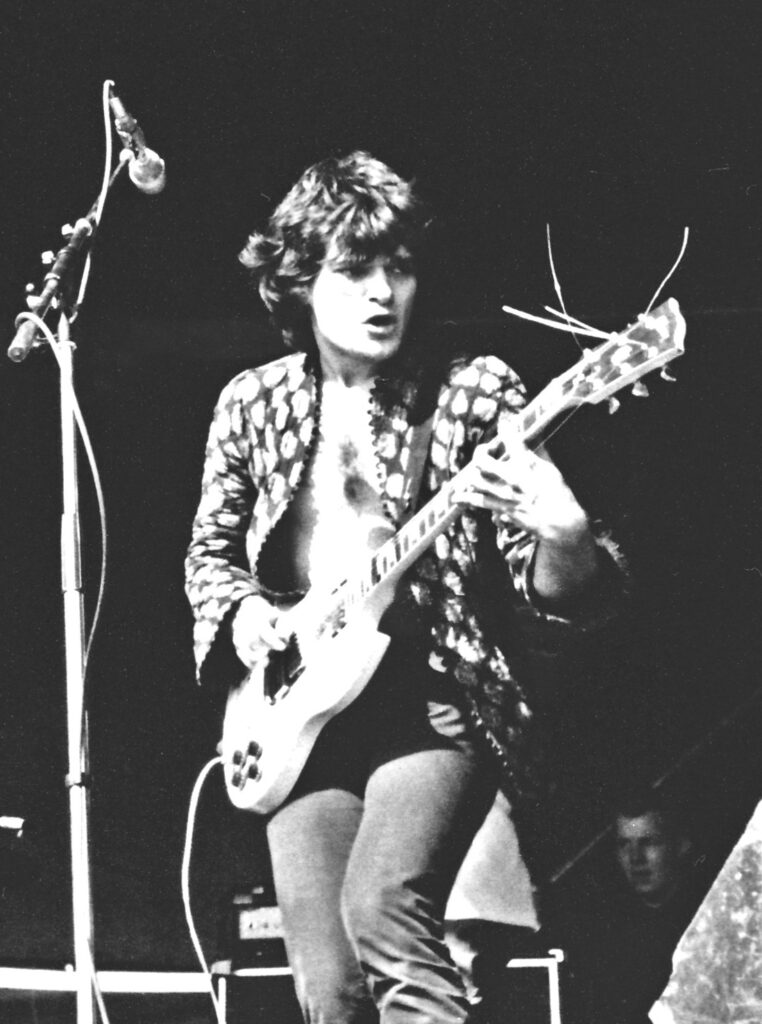
Tell us about your place at Chepstow Road…
It was a beautiful, crumbling Victorian mansion. I remember dodging falling masonry while climbing the stairs. The council had smashed all the loos, baths, and sinks—vandals that they were—so there was only one functioning lavatory in a four-storey house full of musicians and various girlfriends and hangers-on, drug dealers, etc. It lasted about eighteen months. Not bad. It was a squat with all the usual problems that squats were prey to.
The band’s dissolution in 1983 marked the end of an era, but the reunion gig in 1984 sparked the beginning of a new chapter. What motivated the decision to reunite, and how did the response from fans and peers influence the band’s decision to continue performing together?
It was Club Dog. They invited us to play, and so we did. We’d had eighteen months off, so we were a bit rusty, but we had a really good audience. It was fortuitous because Christian Paris and his partner Alex Warwick were there; they ran the Alice In Wonderland club, and they saw all these young freaks and weirdos who had come out to see us, and they booked us to play down at Alice’s. That was recorded as well and put out on a limited edition cassette. We sort of walked straight into a ready-made scene there. I loved it, but it was a bit more fashion victim-oriented than what we were used to. But they were a very friendly crowd, and we played a few times down at Alice’s and also at one of the Scala all-night film festivals that Christian put on. Similarly, we played the Alice’s Mystery Trips a couple of times.
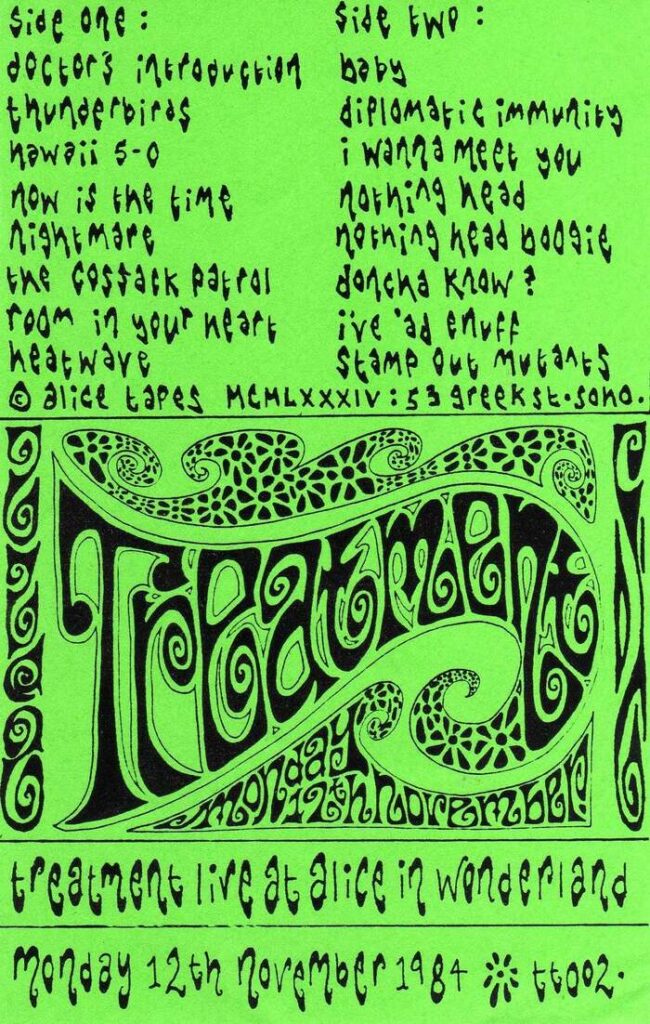
The transition from the first to the second incarnation of TreaTmenT involved various members pursuing new musical projects.
Mmmmm… Sort of. Paul Mutant had a band with his girlfriend Karen. Clive and Gordon got involved with a band called Adolf Bidet and His Bosch Wash. I had a free improv collective named Jacket Xerxophon and His Eggs Legz. We kept ourselves busy.
‘The World Of TreaTmenT’ was released in 1986.
That was Gordon’s compilation, I think. TreaTmenT were limping a bit by then. We played the Crypt in Deptford a lot. We put out the second single, which was really my baby, but I had failed to get distribution for it, so it died a death. That was by the end of 1987.
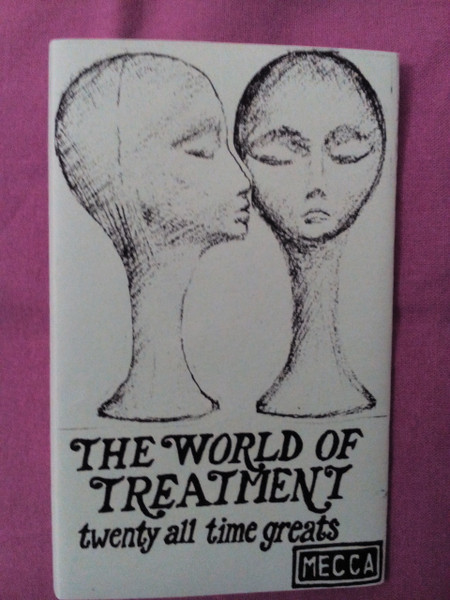
Was your self-titled (also called: ‘Recognise This! Nothing Heads They Told Me I’m Fr’) album from 1989 self-released under the label name of Number! Records? How many copies were pressed? Did you receive any press?
The live album. Yes, it was self-released. I don’t know how many copies were pressed or if it got any press.
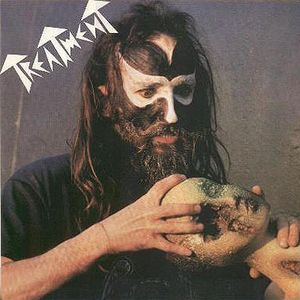
Would love to hear more insight about the making of that album.
It was just a gig at Club Dog. It was a big deal because it was a digital recording. Hah! So what, you know.
The cover artwork is very striking. Is there any concept behind it?
Beyond Clive munching a polystyrene head? Not really. We used to destroy polystyrene heads at every gig.
How did your collaboration with Delerium Records come about, and what was your experience working with them?
Richard Allen—bless him, without whom. He signed us and believed in us. I think he still does.
What are some of the strongest memories from working on ‘Cipher Caput’?
All the basic tracks were laid down at Survival Studio in Acton, on a 16-track. We didn’t spend very long over it. Didn’t have the money.
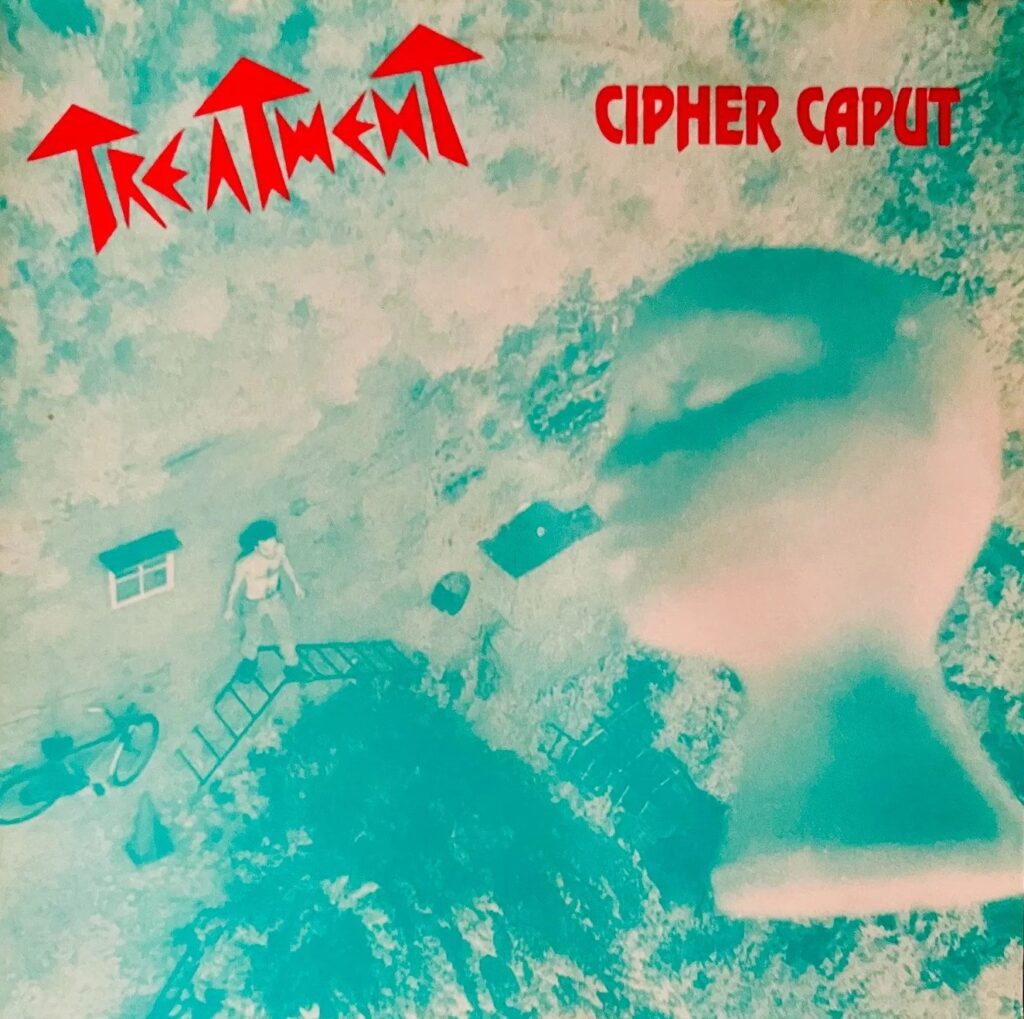
Tell us about the instruments, gear, effects, etc., you had in the band.
Nothing beyond the usual guitars, keyboards, bass, and drums. The “new” album has a lot more in post-production, overdubs, etc., than ‘Cipher Caput’ had.
Reflecting on your early days performing at iconic venues like Alice in Wonderland and The Crypt, how do you feel those experiences shaped the identity and sound of TreaTmenT?
I think our sound and identity were shaped before we ever set foot in those places. We just brought what we had to the party.
Your upcoming release, ‘How Much is Enough?’ was recorded nearly three decades ago. The album was intended to be released on Delerium in 2000 but never was. What was the reason? What motivated the decision to release it now, and how does it feel to finally share this music with the world?
Yes, three decades ago. Nearly all that material was recorded at the same time as ‘Cipher Caput.’ It had a much longer gestation period. There was a lot of overdubbing, a lot of mixing. It sounds much better to my ears. It never came out because Richard got sidetracked by Porcupine Tree being successful, and then Delerium folded. A couple of tracks found their way onto Delerium compilations. We’ve all wanted the album to come out for many years, but life kept getting in the way. But then Gordon died of Covid, which was totally shocking. After that, we just HAD to put it out—as a tribute to him.
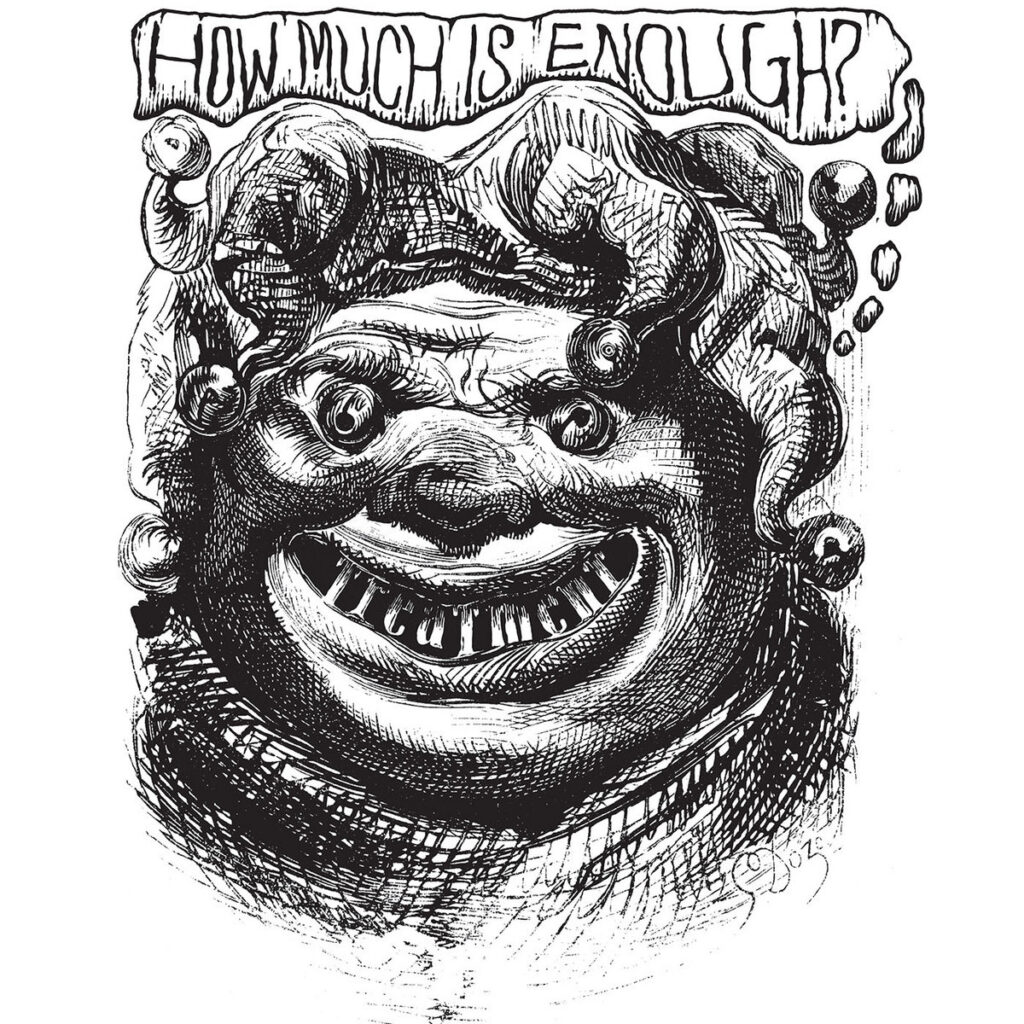
TreaTmenT was among the most psychedelic bands of the neo-psychedelic space rock revival. What elements or influences do you believe contribute to that distinction, and how have you maintained that psychedelic essence over the years?
Geez, I dunno… Lot of swishing noises, I guess.
“We were psychedelic evangelists”
The band insisted on performing in a psychedelicized state, often incorporating light shows into your performances. How do you believe altered states of consciousness influenced your creative process and live performances?
Totally. We were psychedelic evangelists.
Your music is said to be a blend of ’60s psychedelia, ’70s space rock, and punk attitude. How do you navigate merging these diverse influences into a cohesive sound, and what challenges, if any, have you encountered in maintaining that balance?
Other people have said these things. We just played the music that suggested itself to us.
‘How Much is Enough?’ features tracks like ‘Hate the Band’ and ‘Blot Out,’ which seem to touch on themes of disillusionment and rebellion. Can you elaborate on the lyrical and thematic inspirations behind these songs?
‘Hate The Band’ was a bit of a joke. Clive had this marvellous pseudo Spaghetti Western incidental music, and we improvised the lyrics. Someone said it was about the music press (which used to be very powerful in the 80s), but I always thought it was about hating the other bands at the gig and also hating the other members of the TreaTmenT for one reason or another. Most good bands hate each other, you know. But you have to laugh. ‘Blot Out’ was improvised on the spot by Clive at the very first TreaTmenT gig. I thought it was about dealing with hostile audience members.
With the passing of guitarist Gordon Leach in 2021, the release of ‘How Much is Enough?’ takes on a poignant significance. How has his influence shaped the band’s dynamic and musical direction, both in the past and in the present?
Gordon was absolutely central in so many ways. It would be impossible to overstate how important he was.
The album artwork and packaging for ‘How Much is Enough?’ include photos, memorabilia, and a full band history. What significance do these elements hold for you, and how do they enhance the listener’s experience of the music?
It’s closure of a sort. Wrapping up unfinished business.
TreaTmenT has been associated with other notable bands of the neo-psychedelic scene like Ozric Tentacles and Dr & The Medics. How do you perceive your role within that musical community, and what connections or collaborations have been particularly meaningful for you?
I remember the Ozrics’ first gig. They played a Gong riff in 4-4 when it should have been in seven. I think. I didn’t pay much attention to them after that. Lovely people, though. They were actually very smart in that they figured out that what the audience wanted was a stoned soundtrack to their stoned evening. Nothing wrong with that, but the TreaTmenT were always about challenging people’s perceptions. We wanted the audience’s undivided attention and we would get it by making absurd juxtapositions of hugely different musical styles. We jolted and jarred. Sharp edges. Dr & The Medics were really a glam rock band. They were great and put on a really good show. But beyond being on some of the same stages, we didn’t really have much in common. Again, lovely people. Especially Clive and Wendi.
What would be the craziest gig you ever did?
We used to play Hendon Rugby Club and Hendon Football Club back in the day. There was a lot of mushroom tea involved. Danielle Dax taking her clothes off. A lot of tearaway kids. That was pretty crazy.
The band’s gigs were known for their unpredictability and experimentation, often fueled by psychedelics. How did these elements contribute to the unique atmosphere of a Treatment performance, and what challenges did they present for the band? Do you feel that influenced who you became as musicians?
That was what we did. Every gig was different. Sometimes we would improvise new material on the spot. We rarely knew what was coming next. We were out there as far as possible. You have to try and remember the context of the times—the true awfulness of the ’80s live scene. We must have looked and sounded like we came from another planet a lot of the time.
Looking back, what was the highlight of your time in the band? Which songs are you most proud of? Where and when was your most memorable gig?
I think we were probably at our peak in 1981/1982. I was proud of ‘Love’s Getting Nowhere’ and ‘Restless.’ They didn’t sound like anyone else, but there’s still a melodic aspect. I think the most memorable gig for me was Stonehenge 1982. Also, the Scala all-nighter. That was quite something.
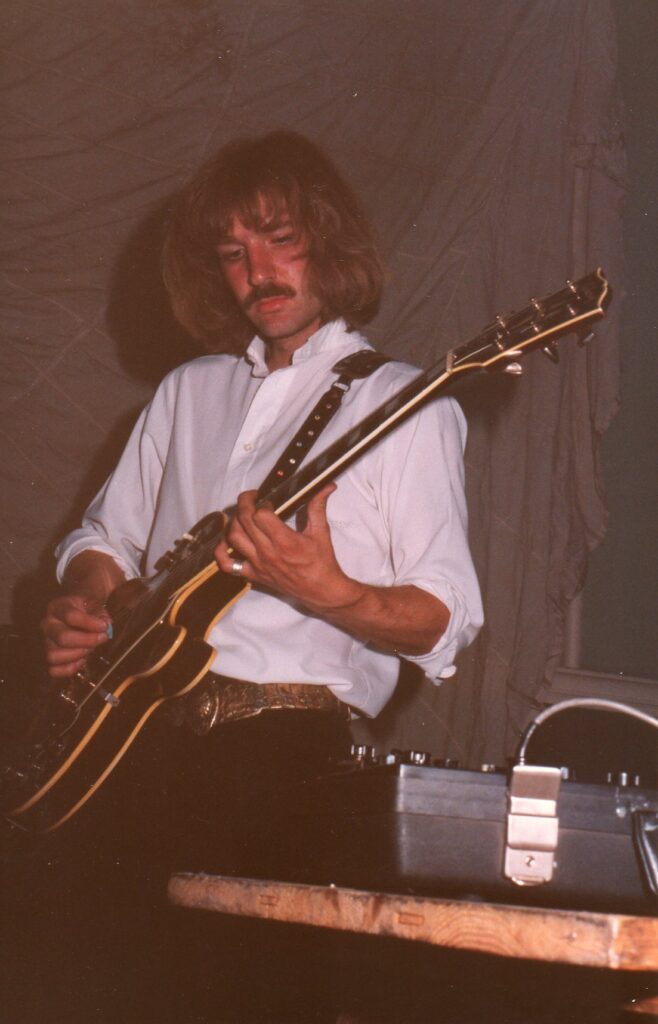
What occupied your lives and the lives of other members later on? Were you still in touch with other members? Is any member still involved with the music?
Well, these guys are like relations to me. Family. We don’t see each other very often, but I could never envisage a time when we weren’t in touch. For myself, I’m a musician. That’s what I do. And I have been doing it since I was 15. I actually did a gig with Clive only last month.
Is there any more unreleased material by Treatment or related projects?
Yes, there’s still stuff in the can. Who knows?
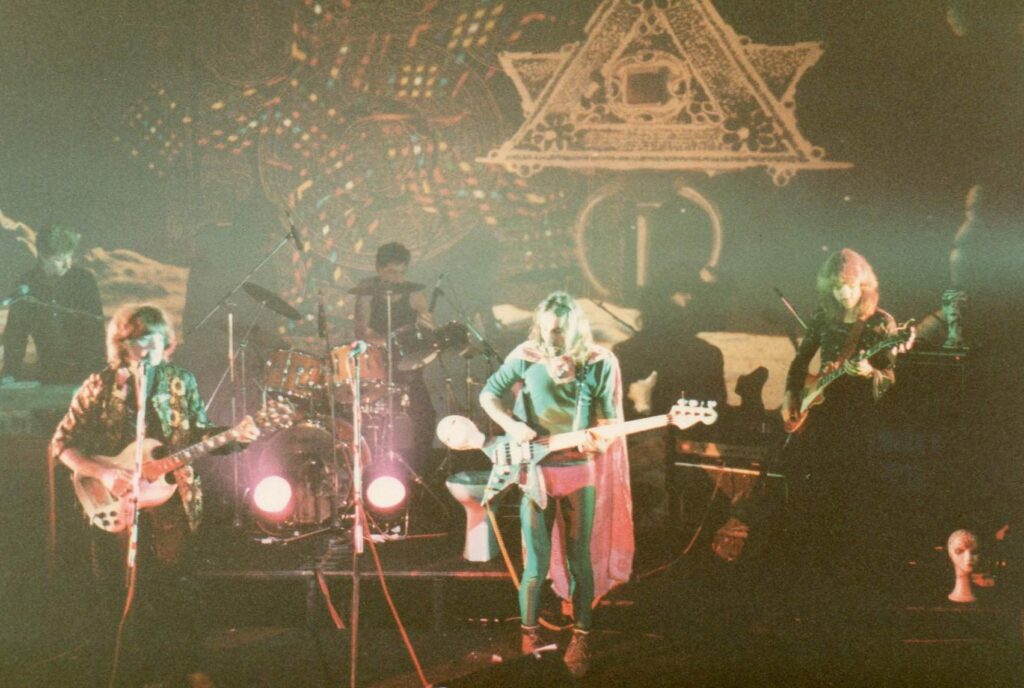
Thank you for taking your time. The last word is yours.
I just want to make it clear that these are my own personal thoughts and impressions of things that mostly happened a very long time ago. It’s not by any means definitive, nor should it be taken that way. But I’m glad that there is still some interest in the TreaTmenT. I remember often thinking—well, I like it—but I was always pleasantly surprised when anyone else did. The TreaTmenT were unique, for better or for worse. In that sense, the music we made is quite timeless—even if it does employ the language of rock music: electric guitars and drums, etc. Finally, it doesn’t sound like anyone else, and I’m proud of that.
Klemen Breznikar
Headline photo: Treatment at the Scala (January 1985) | Photo by Joe Kershaw
TreaTmenT Official Website / Bandcamp

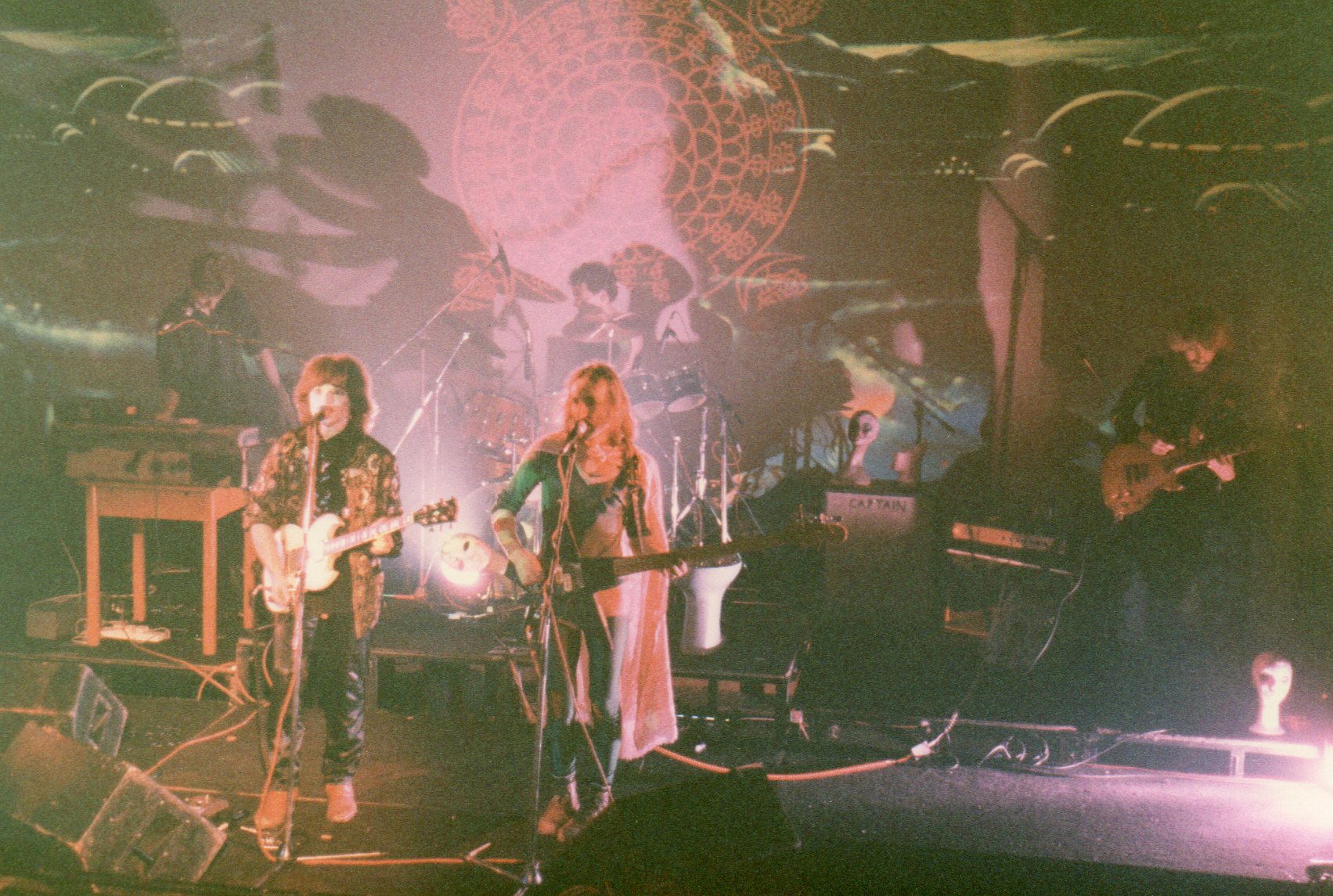


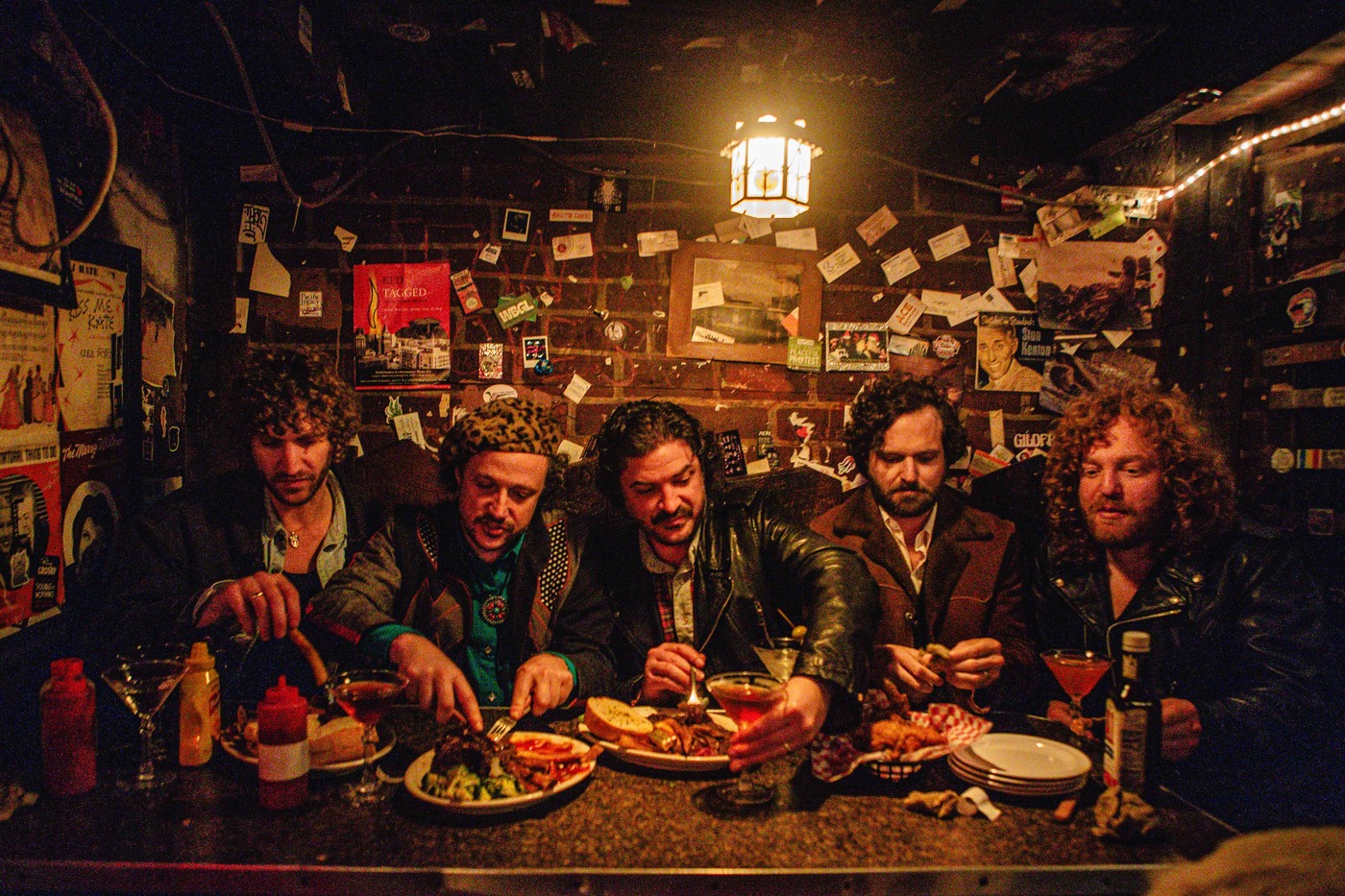
Great article. I saw them several times in nth London including Hendon RFC and Stonehenge. They were amazing and made a massive impression on me as a young student